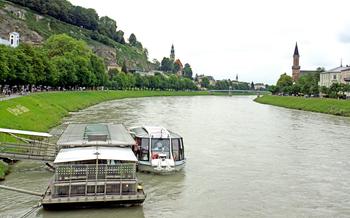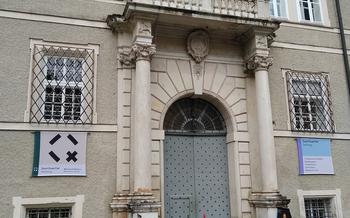
Mirabell Palace and Gardens, Salzburg
- A Journey to Braunau am Inn
- The Mirabell Palace: A Baroque Masterpiece
- The Mirabell Gardens: An Oasis of Beauty
- Exploring the Palace and Gardens
- The Pegasus Fountain: A Symbol of Inspiration
- The Hedge Maze: A Fun Challenge
- The Zwerglgarten: A World of Dwarves
- The Rose Garden: A Fragrant Paradise
- The Grand Fountain: A Spectacle of Water
- The Marble Hall: A Venue for Elegance
- The Music Pavilion: Melodies in the Gardens
- The Orangery Café: A Culinary Delight
- Insider Tip: Unveiling Hidden Gems
A Journey to Braunau am Inn
Braunau am Inn, a charming town nestled on the banks of the Inn River, holds a significant place in history as the birthplace of Adolf Hitler. Despite this somber association, Braunau am Inn offers a rich tapestry of experiences for discerning travelers. Located in the picturesque Innviertel region of Upper Austria, the town is easily accessible by road, rail, or air. The best time to visit Braunau am Inn is during the summer months, when the weather is pleasant and the town comes alive with cultural events and festivals. Whether you choose to stay in a cozy guesthouse or a modern hotel, Braunau am Inn offers a range of accommodation options to suit every taste and budget.
The Mirabell Palace: A Baroque Masterpiece
The Mirabell Palace, a stunning masterpiece of Baroque architecture, stands as a testament to the artistic and cultural heritage of Salzburg. Built in the early 17th century by Prince-Archbishop Wolf Dietrich Raitenau, the palace initially served as a summer residence for the prince and his mistress, Salome Alt. Its impressive facade, adorned with intricate stucco work and elegant sculptures, hints at the grandeur that awaits visitors within.
Over the centuries, the Mirabell Palace has undergone several renovations and expansions, each adding to its architectural charm. The palace's interior is a treasure trove of Baroque artistry, with opulent state rooms featuring ornate frescoes, crystal chandeliers, and finely crafted furniture. Highlights include the Marble Hall, with its stunning marble floor and ceiling frescoes, and the Golden Hall, renowned for its intricate gold leaf decorations.
Today, the Mirabell Palace serves as a cultural and administrative center, housing various government offices and hosting prestigious events, concerts, and exhibitions. It is open to the public for guided tours, offering visitors a glimpse into the lavish lifestyle of Salzburg's former prince-archbishops and the palace's rich history.
The Mirabell Gardens: An Oasis of Beauty
The Mirabell Gardens, an enchanting masterpiece of Baroque artistry, are an integral part of the Mirabell Palace complex. Spread over 17 hectares, these gardens are a symphony of meticulously manicured lawns, vibrant flowerbeds, shimmering fountains, and captivating sculptures. The gardens are divided into several themed sections, each offering a unique experience.
Strolling through the Formal Garden, visitors are greeted by a mesmerizing display of geometric patterns, meticulously trimmed hedges, and vibrant flowerbeds. The Rose Garden, a fragrant paradise, boasts over 100 varieties of roses, each vying for attention with its exquisite blooms. The Dwarf Garden, a whimsical wonderland, features a collection of intricate dwarf statues, each with its own distinct personality.
The Orangery Garden, a tropical oasis, houses a variety of exotic plants and flowers, creating a lush and vibrant atmosphere. The Grand Fountain, a majestic spectacle of water, cascades down a series of terraces, creating a mesmerizing display. The Marble Hall, an elegant venue, is surrounded by lush greenery, providing a picturesque backdrop for special events.
Throughout the gardens, visitors can discover hidden gems, such as the Music Pavilion, where concerts and performances are held, and the Orangery Café, where visitors can savor delicious refreshments while enjoying the serene garden views. The Mirabell Gardens are a true testament to the artistry and vision of the Baroque era, offering a feast for the senses and a tranquil escape from the bustling city.
Exploring the Palace and Gardens
To fully appreciate the grandeur of the Mirabell Palace and Gardens, take the time to explore them at a leisurely pace. Start with the palace itself, admiring its intricate facade and the beautiful staterooms inside. Guided tours are available, providing insights into the history and significance of the palace.
Once you've explored the palace, step into the gardens, a masterpiece of Baroque landscaping. Follow the well-maintained paths that wind through the gardens, discovering hidden fountains, sculptures, and viewpoints. Take a moment to sit on one of the many benches and soak in the tranquil atmosphere.
To capture the best photos, visit the gardens early in the morning or late in the evening, when the light is at its most flattering. Experiment with different angles and perspectives to capture the essence of the gardens.
For visitors with disabilities, the Mirabell Palace and Gardens are well-equipped with ramps, elevators, and accessible restrooms. Guided tours with sign language interpreters or audio descriptions can be arranged in advance.
The Pegasus Fountain: A Symbol of Inspiration
Amidst the verdant splendor of the Mirabell Gardens, the Pegasus Fountain stands as an iconic symbol of inspiration and creativity. This majestic fountain, sculpted by the renowned sculptor Kaspar Gras in 1690, depicts the mythical winged horse, Pegasus, triumphantly emerging from a rocky outcrop, its powerful wings outstretched as if ready to soar into the heavens.
The fountain's intricate design and symbolism have captivated visitors for centuries. Pegasus, in Greek mythology, represents the power of imagination and poetic inspiration, and its presence in the gardens serves as a reminder to embrace creativity and let one's imagination run wild.
Located at the heart of the gardens, the Pegasus Fountain commands attention with its grandeur and elegance. The cascading waters, sparkling in the sunlight, create a mesmerizing spectacle that adds to the fountain's allure. Visitors can find respite and inspiration as they sit by the fountain, surrounded by the beauty of the gardens, and let their thoughts take flight.
Over the years, the Pegasus Fountain has become an emblem of Salzburg's rich cultural heritage. Its artistic significance and cultural impact have made it a beloved landmark, attracting visitors from around the world who come to marvel at its beauty and draw inspiration from its symbolic meaning.
Legends and stories have woven themselves around the Pegasus Fountain, adding to its mystique and charm. One legend tells of a young artist who, while gazing upon the fountain, was struck by a sudden burst of inspiration that led to the creation of his masterpiece. Another story speaks of a princess who, after drinking from the fountain's waters, gained the ability to fly, soaring above the gardens and the city of Salzburg.
Whether you're an artist seeking inspiration, a traveler drawn to beauty, or simply someone who appreciates the magic of mythology, the Pegasus Fountain is a must-see attraction in the Mirabell Gardens. Let its beauty and symbolism ignite your imagination and leave you with a lasting sense of wonder.
The Hedge Maze: A Fun Challenge
Nestled within the Mirabell Gardens, the Hedge Maze offers a unique and challenging experience for visitors. Its intricate pathways, lined with tall, manicured hedges, create a verdant labyrinth that tests one's sense of direction and problem-solving skills. Entering the maze, visitors are greeted with a sense of mystery and anticipation as they embark on a journey to find the center.
Navigating the maze requires patience, observation, and a bit of luck. As you wander through the winding paths, it's easy to lose track of direction and find yourself turning in circles. The key to success lies in paying attention to the layout of the maze, using landmarks as reference points, and avoiding dead ends.
For those seeking an extra challenge, try to find the hidden shortcuts and secret passages that allow you to bypass certain sections of the maze. These hidden paths, often cleverly concealed within the hedges, add an element of surprise and discovery to the experience.
The Hedge Maze has a rich history dating back to the 17th century when it was first created as a form of entertainment for the prince-archbishops of Salzburg. Over the years, the maze has undergone several renovations to maintain its beauty and complexity. Today, it remains a popular attraction, drawing visitors from around the world who come to test their skills and experience the thrill of finding their way through its verdant labyrinth.
If you're visiting the Mirabell Gardens, don't miss out on the opportunity to explore the Hedge Maze. It's a fun and challenging experience that will leave you with a sense of accomplishment and a newfound appreciation for the art of topiary.
The Zwerglgarten: A World of Dwarves
Amidst the lush greenery of the Mirabell Gardens lies a charming and whimsical attraction—the Zwerglgarten, or the Dwarf Garden. This enchanting corner of the gardens features a collection of 28 stone statues depicting mischievous dwarfs engaged in various activities, evoking a sense of playfulness and wonder.
Crafted by the talented sculptor Kaspar Gras in the 17th century, these dwarf statues stand as testaments to the Baroque era's fascination with the grotesque and the fantastical. Each dwarf is unique in its expression and posture, capturing a range of emotions and personalities. Some dwarfs appear joyful and playful, while others seem contemplative or even mischievous.
The Zwerglgarten holds historical significance as one of the earliest examples of a dwarf garden in Europe. It is believed that such gardens were inspired by the medieval tradition of court jesters and dwarfs, who were often depicted in art and literature as symbols of wisdom and entertainment.
Similar dwarf gardens can be found in other parts of the world, notably the Zwerglgarten in Kassel, Germany, and the Boboli Gardens in Florence, Italy. These gardens showcase the enduring appeal of dwarf statues as whimsical and artistic creations that spark curiosity and delight in visitors of all ages.
Practical Information:
- Location:
The Rose Garden: A Fragrant Paradise
Amidst the lush greenery of the Mirabell Gardens, a fragrant oasis awaits visitors—the Rose Garden. This enchanting haven is home to a captivating array of roses, each bloom a testament to nature's artistry. Stroll through the meticulously manicured paths, inhaling the heady scent that permeates the air, and marvel at the vibrant colors and delicate forms of these floral masterpieces.
The Rose Garden boasts an impressive collection of over 1,200 roses, representing more than 100 different varieties. From classic red roses to elegant white blooms and captivating shades of pink, yellow, and lavender, there is a rose to suit every taste and preference. Each variety has its own unique story to tell, with names like 'Gruss an Aachen', 'Papa Meilland', and 'Queen Elizabeth' hinting at their rich history and cultural significance.
As you wander through the Rose Garden, take a moment to appreciate the meticulous care and attention that goes into maintaining this fragrant paradise. Expert gardeners spend countless hours pruning, fertilizing, and nurturing each rose bush, ensuring that they bloom in their full glory throughout the season. The result is a breathtaking display of beauty that is sure to leave a lasting impression.
Whether you are a passionate rose enthusiast or simply someone who appreciates the simple beauty of nature, the Mirabell Rose Garden is a must-visit destination. Immerse yourself in the intoxicating fragrance, admire the vibrant colors, and let the tranquility of this enchanting oasis soothe your senses.
The Grand Fountain: A Spectacle of Water
The Grand Fountain is a magnificent centerpiece of the Mirabell Gardens, captivating visitors with its grandeur and intricate design. Towering over the manicured lawns, the fountain stands as a testament to the Baroque era's love of spectacle and artistry.
Measuring an impressive 28 meters in height, the fountain's cascading waters create a mesmerizing display that dances and sparkles in the sunlight. The fountain's intricate carvings and sculptures depict mythological figures and scenes, adding to its visual appeal and symbolic significance.
During the summer months, the Grand Fountain comes alive with vibrant water displays and light shows that illuminate the gardens with a magical glow. These shows are a popular attraction for both locals and tourists, who gather around the fountain to marvel at the spectacle.
The Grand Fountain is not only a stunning work of art but also a symbol of the city of Salzburg's rich cultural heritage. Its presence in the Mirabell Gardens serves as a reminder of the city's enduring love of beauty, nature, and artistic expression.
Similar grand fountains can be found in other cities around the world, each with its unique design and significance. In Rome, the Trevi Fountain is a popular tourist destination, known for its opulent Baroque architecture and the legend that throwing a coin into the fountain will ensure a return to the Eternal City. The Jet d'Eau in Geneva, Switzerland, is another iconic fountain, shooting a powerful stream of water high into the sky and providing breathtaking views of the city and lake.
The Marble Hall: A Venue for Elegance
The Marble Hall, an architectural masterpiece within the Mirabell Palace, stands as a testament to the grandeur and opulence of the past. Constructed in the 17th century, this breathtaking hall boasts intricate marble carvings, elegant chandeliers, and a soaring ceiling adorned with exquisite frescoes.
The Marble Hall served as a grand ballroom, hosting lavish parties, receptions, and celebrations during the reign of Prince-Archbishop Wolf Dietrich von Raitenau. Its opulent atmosphere and acoustics made it an ideal venue for musical performances, with renowned composers such as Mozart and Haydn gracing its stage.
Throughout history, the Marble Hall has witnessed countless significant events. It hosted the signing of the Treaty of Salzburg in 1816, which marked the end of the Napoleonic Wars and reshaped the political landscape of Europe. In the 20th century, the hall underwent a meticulous restoration, preserving its original splendor and transforming it into a sought-after location for prestigious events, concerts, and exhibitions.
Similar to the Marble Hall, other palaces worldwide boast grand halls that serve as venues for elegance and cultural events. The Hall of Mirrors in the Palace of Versailles, France, is renowned for its opulent décor and its role in significant historical events. The Grand Ballroom of the Hofburg Palace in Vienna, Austria, is another architectural marvel, hosting grand receptions and state ceremonies. These magnificent halls continue to inspire awe and admiration, offering a glimpse into the grandeur and history of their respective palaces.
The Music Pavilion: Melodies in the Gardens
Situated amidst the lush greenery of the Mirabell Gardens, the charming Music Pavilion stands as a testament to the harmonious blend of music and nature. Its history is deeply intertwined with the cultural legacy of Salzburg, as it was once a favored venue for musical performances and concerts. The pavilion's intricate design and acoustics create an enchanting atmosphere, transporting visitors to a bygone era of elegance and artistry.
Today, the Music Pavilion continues to host a variety of musical events and concerts, ranging from classical recitals to contemporary performances. Its intimate setting and superb acoustics make it a popular choice for musicians and music lovers alike. Attending a concert in this enchanting venue is an unforgettable experience, allowing visitors to immerse themselves in the magic of music while surrounded by the beauty of the gardens.
Similar music pavilions can be found in other renowned gardens around the world, each with its own unique character and charm. The Belvedere Music Pavilion in Vienna, Austria, offers a stunning backdrop of the Belvedere Palace and its gardens. The Royal Pavilion in Brighton, England, is a whimsical and extravagant structure that reflects the Regency era's love of music and entertainment. These pavilions serve as reminders of the enduring power of music to enhance the beauty of natural surroundings and create unforgettable experiences for visitors.
The Orangery Café: A Culinary Delight
Indulge in culinary delights at the Orangery Café, a charming oasis nestled amidst the enchanting Mirabell Gardens. The café's menu offers a tempting array of sweet and savory treats, crafted with fresh, local ingredients and a touch of Austrian flair. From traditional Viennese pastries to light lunches and refreshing beverages, there's something to satisfy every palate.
The Orangery Café's ambiance is as inviting as its menu. Housed within the historic Orangery building, the café features elegant interiors adorned with intricate frescoes and gleaming chandeliers. Outside, a delightful terrace beckons visitors to bask in the sun and savor their culinary delights while surrounded by the beauty of the gardens.
Whether you're seeking a quick bite to refuel after exploring the palace and gardens or a leisurely afternoon tea, the Orangery Café offers a memorable dining experience. Don't miss the signature Orangery Cake, a delectable masterpiece that embodies the café's charm and culinary prowess.
Insider Tip: Unveiling Hidden Gems
Beyond the well-trodden paths of the Mirabell Palace and Gardens, there lies a treasure trove of hidden gems waiting to be discovered by the curious traveler. Venture behind the palace to uncover a secret garden adorned with enchanting sculptures and tranquil fountains. This secluded oasis offers a serene escape from the bustling crowds and invites you to savor a moment of solitude amidst nature's embrace.
A short stroll from the gardens leads to the venerable St. Peter's Abbey, a Benedictine monastery steeped in history and spirituality. Explore its ancient cloisters, admire the intricate frescoes that adorn its walls, and marvel at the towering spires that reach towards the heavens. The abbey's serene atmosphere provides a sanctuary for reflection and contemplation, inviting you to connect with your inner self.
For a refreshing change of perspective, embark on a leisurely stroll along the banks of the Salzach River. This picturesque promenade offers breathtaking panoramic views of the city, with the snow-capped Alps serving as a majestic backdrop. Capture the essence of Salzburg's natural beauty as you breathe in the fresh air and soak up the tranquil ambiance.
Delve deeper into the city's rich history and culture at the Salzburg Museum, housed in a magnificent 16th-century building. Immerse yourself in captivating exhibits that showcase Salzburg's artistic heritage, from traditional crafts to contemporary masterpieces. Learn about the city's famous residents, including Mozart and his musical legacy, and gain a deeper understanding of the factors that have shaped Salzburg's unique identity.









